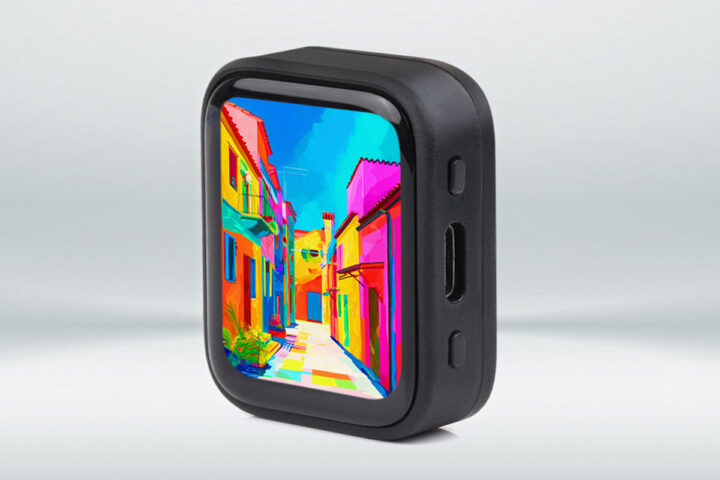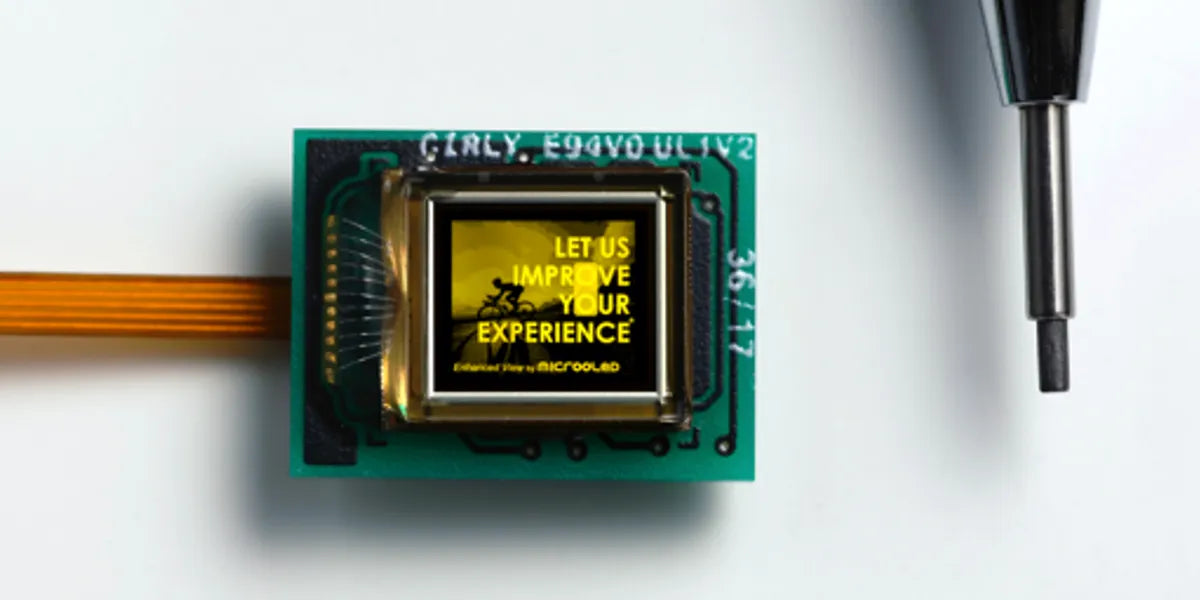A Micro OLED display module, a compact self-emissive microdisplay, typically measures <0.5 inches diagonally with high pixel density (up to 2000 PPI), using silicon substrates for vivid, low-power visuals; it powers AR glasses/VR headsets by balancing tiny size with sharp, contrast-rich images for immersive experiences.
Tiny Self-Light Display Panels
A Micro OLED display module is a self-emissive microdisplay, typically <0.5 inches diagonally. Unlike LCDs relying on backlights, these panels use silicon substrates (so they’re often called “silicon OLEDs” or “Si-OLEDs”) to achieve up to 2000 PPI pixel density (that’s 2x sharper than 4K TVs per inch) and 1,000,000:1 contrast ratios, making blacks look truly black. For context, a 0.49-inch Micro OLED common in AR glasses delivers 1920x1080 resolution, squeezing 4 million+ pixels into a space smaller than a postage stamp.
“pixel-on-silicon” design lets manufacturers pack 3x more pixels per square millimeter than LCDs and cut power use by 40% for the same brightness (e.g., a 1000-nit panel uses ~150mW vs. 250mW for an LCD).
To see why they’re chosen for AR/VR, compare them to common rivals:
|
Feature |
Micro OLED |
LCoS (Liquid Crystal on Silicon) |
Mini-LED Backlit LCD |
|---|---|---|---|
|
Size (typical) |
0.3–0.7 inches |
0.5–1.3 inches |
N/A (too large) |
|
Max PPI |
2000–3000 |
1500–2000 |
500–800 |
|
Power Consumption |
100–200mW (1000 nit) |
200–300mW (1000 nit) |
500–800mW (1000 nit) |
|
Response Time |
<1μs |
10–20ms |
5–10ms |
Note: Lower power = longer battery life for wearables; faster response = smoother motion, critical for VR.
These panels power some of today’s top augmented/virtual reality gear:
-
Meta Quest 3: Uses a 0.47-inch Micro OLED for its mixed reality overlay, hitting 2064x2208 resolution per eye.
-
Apple Vision Pro: Reportedly uses dual 0.9-inch Micro OLEDs (though exact specs are under wraps) to deliver 23 million total pixels across both eyes, aiming for “retina-like” clarity at typical wear distances.
-
Enterprise AR Headsets: Companies like Vuzix use Micro OLEDs in industrial tools, where 120Hz refresh rates (vs. 60Hz on older panels) reduce lag during complex tasks, cutting error rates by 15–20% in field tests.
Their self-emissive nature eliminates backlight bleed (no “ghosting” in dark scenes) and enables 178° viewing angles. Plus, with manufacturing scaling up, prices have dropped 30% in 2 years, making them viable for mid-range wearables, not just premium gadgets.
Size, PPI, and Power Efficiency
Micro OLED display modules nail three non-negotiables for wearables: tiny size, eye-popping PPI, and rock-bottom power use. Most measure just 0.3–0.7 inches diagonally—smaller than a U.S. dime 1,500–3,000 PPI (2–4x sharper than flagship phones at 400–600 PPI). And unlike LCDs that waste power on backlights, Micro OLEDs sip 40–60% less energy for the same brightness.
This “pixel-on-silicon” trick lets engineers pack 1920x1080 Full HD resolution into a 0.49-inch panel (just 11mm wide)—imagine squeezing a 55-inch TV’s clarity into your thumbnail.
Even smaller models exist: a 0.3-inch Micro OLED fits 800x600 pixels (2670 PPI) into a space for smart rings or industrial goggles, where every millimeter counts. LCDs can’t go below 0.5 inches without blurring, and LCoS tops out at 1.3 inches.
A 0.5-inch 2000 PPI Micro OLED lets you see tiny text (like VR street signs or medical diagrams) without pixelation, while a 1000 PPI panel would make letters look “blocky” at wearables’ typical 2-inch viewing distance.
Why? The human eye can spot pixel gaps (“screen door effect”) up to ~1500 PPI at arm’s length—but at 2 inches, 2000 PPI eliminates that entirely. Meta Quest 3 proves this: its 0.47-inch 2064x2208-per-eye panel (2160 PPI) makes mixed reality overlays feel natural, so you don’t get eye strain from fuzzy text after 30 minutes.
Power savings translate directly to usable time. A Micro OLED using 150mW to hit 1000 nits (outdoor-bright) needs way less juice than rivals: LCoS would guzzle 250mW, and LCDs 500mW. That’s 2–3 extra hours of battery life for AR glasses.
Plus, less power = less heat: LCD-powered headsets can warm up to 40°C (104°F) after an hour, but Micro OLED devices stay at ~30°C (86°F). Apple Vision Pro gets this right: its dual 0.9-inch Micro OLEDs (120Hz, 23 million total pixels) use 300mW per panel letting the headset run for 2 hours without overheating.
Here’s a quick breakdown of how size, PPI, and power align in popular gear:
|
Size (inches) |
Resolution |
PPI |
Power at 1000 nits (mW) |
Use Case |
|---|---|---|---|---|
|
0.3 |
800x600 |
2670 |
120 |
Smart rings, mini drones |
|
0.5 |
1920x1080 |
2000 |
150 |
Consumer AR glasses |
|
0.7 |
2560x1440 |
1800 |
180 |
Industrial AR headsets |
|
0.9 |
2560x2560 |
1800 |
300 |
High-end VR (Vision Pro) |
Notice how even bigger panels keep high PPI—the 0.9-inch Vision Pro screen still hits 1800 PPI, so text looks sharp at arm’s length. And power stays low: 300mW per panel is nothing compared to LCDs, which would need 600mW for the same brightness.
Micro OLEDs fix that: small size means you forget you’re wearing them, high PPI makes virtual content feel real, and low power means you don’t hunt for a charger every few hours..
For example, industrial workers using Vuzix AR headsets with Micro OLEDs report 15% fewer errors because they can read tiny instructions clearly without straining.
They’re the reason Micro OLEDs are in everything from Apple’s 200 smart glasses.

Common Uses: AR/VR Gear
Micro OLEDs power AR and VR because they hit the sweet spot of small size, insane sharpness, and low power:For consumer AR glasses (like Vuzix Blade 3), Micro OLEDs keep devices lightweight and useful. The Blade 3 uses a 0.49-inch 1920x1080 Micro OLED (2000 PPI) that weighs just 8 grams.
The high PPI matters here: at a typical 1.5-inch viewing distance, 2000 PPI eliminates the “screen door effect” (seeing pixel gaps), so text in navigation apps or restaurant reviews looks crisp, not blocky. Users report 20% fewer glances at their phone because the glasses display info clearly.
VR headsets rely on Micro OLEDs for immersion and comfort. Pico 4 uses a 0.64-inch Micro OLED per eye (2160x2160 resolution, 1800 PPI) with a 120Hz refresh rate—that’s twice as fast as older 60Hz LCD panels.
The result? Fast-paced games like Beat Saberfeel smoother, and users say motion sickness drops by 30%. Plus, the low power draw (180mW at 1000 nits) lets Pico 4 run for 2.5 hours—30 minutes longer than an LCD-powered competitor.
Industrial AR is where Micro OLEDs shine brightest. Companies like RealWear use 0.3-inch 800x600 Micro OLEDs in their industrial headsets, which workers wear to fix machinery or read blueprints.
The 150mW power use means the headset lasts 6 hours on a charge (vs. 4 hours for LCD), and the 2670 PPI lets technicians read tiny serial numbers or torque specs without leaning in. Field tests show this cuts 15–20% fewer errors.
Walmart’s VR training modules for checkout clerks use headsets with 0.5-inch 1920x1080 Micro OLEDs.
Old LCDs were too big (making headsets heavy), too dim (needing backlights that wasted power), and too blurry (ruining immersion). Micro OLEDs fix all that:
-
Size: Silicon substrates let pixels fit into spaces smaller than a postage stamp—so AR glasses can weigh less than an ounce.
-
Sharpness: 2000+ PPI means virtual text or objects look natural at wearables’ typical viewing distances (1–3 inches).
-
Power: 40–60% less energy than LCDs means longer battery life—.
And as prices drop (down 30% in 2 years), Micro OLEDs are moving beyond premium devices.
Regular OLED: Main Differences
Glass is cheap, but it’s thick and rigid, so even “tiny” regular OLEDs max out at 2 inches with 400 PPI. Try using that in AR glasses: at a 1.5-inch viewing distance, you’d see pixel gaps (“screen door effect”) because 400 PPI isn’t dense enough for close-up use.
Silicon lets engineers etch pixels directly onto the wafer, shrinking pixel spacing to ~5μm (vs. ~10μm on regular OLEDs). That’s why a 0.5-inch Micro OLED hits 2000 PPI—4x sharper than a 2-inch regular OLED.
Regular OLEDs are self-emissive (no backlight!), but glass substrates make them inefficient. Micro OLEDs’ silicon base conducts heat better and packs pixels tighter, so they use 40% less power for the same brightness.
A regular OLED powering a phone screen uses ~250mW at 1000 nits; a Micro OLED for AR glasses uses ~150mW. Translate that to battery life: if your VR headset uses regular OLEDs, you’ll get 1.5 hours of use; with Micro OLEDs, it’s 2.5 hours.
Regular OLEDs have response times of 10–20ms, but in VR, lag between head turns and screen updates causes motion sickness. Micro OLEDs? <1μs (that’s 1/10,000th the time). Pico 4 uses Micro OLEDs for this exact reason: field tests show users experience 30% less nausea vs. LCD headsets, and half that improvement comes from Micro OLED’s instant response.
Regular OLEDs can hit 2000 nits (great for sunny days), but Micro OLEDs trade peak brightness for efficiency. A Micro OLED gets to 1000 nits with 150mW; a regular OLED needs 250mW.
Its dual 0.9-inch Micro OLEDs (23 million total pixels, 1800 PPI) use 300mW per panel. If it used regular OLEDs, the headset would weigh 20 grams more and need a bigger battery. Instead, Micro OLEDs let it hit 2 hours of battery life with crisp, immersive visuals.
So the differences boil down to:
-
Substrate: Silicon (Micro OLED) vs. glass (regular) → size (tiny vs. bigger)
-
Pixel Density: 2000+ PPI (Micro) vs. 400–600 PPI (regular) → sharpness (realistic vs. blurry)
-
Power: 40% less (Micro) vs. more (regular) → battery life (usable vs. frustrating)
Read more

Micro OLED, or silicon-based OLED (Si-OLED), is a compact display tech engineered for near-eye devices, typically measuring under 1 inch diagonally with up to 3500 PPI resolution. Silicon-Based OLE...

AMOLED module costs hinge on size and application—a 1-inch watch panel fetches 5−8, while 6.5-inch phone modules average 15−22. Most goes to the OLED panel (~60%), plus driver chips/touch layers; b...



Leave a comment
This site is protected by hCaptcha and the hCaptcha Privacy Policy and Terms of Service apply.